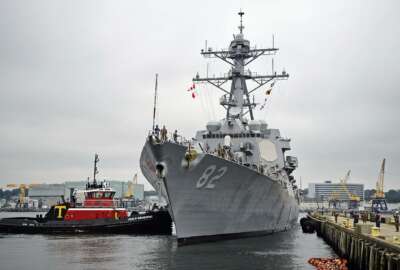
Pentagon plans new initiatives to tackle long-term sustainment costs
The Defense Department is working on new initiatives to reduce the long-term ownership costs of its major platforms. While those systems are expensive up-front,...
Best listening experience is on Chrome, Firefox or Safari. Subscribe to Federal Drive’s daily audio interviews on Apple Podcasts or PodcastOne.
New military weapons platforms are quite expensive — and nearly always more expensive than they were supposed to be. But almost no matter what the up-front price tag is, it’s just a shadow of the all-in cost to keep that ground vehicle, aircraft carrier or fighter jet outfitted with parts and available for its mission until it’s eventually retired.
It’s still the case that sustainment expenses make up about 70% of the average weapons system’s total lifecycle cost. DoD leaders have fretted over that imbalance forever, and have long understood that decisions made early in a system’s design have a lot to do with its total ownership price. But the Pentagon has a couple of new strategies it hopes will address the problem.
For starters, DoD is funding a new project that’s meant to make addressing long-term sustainment costs a priority rather than an afterthought in new system design.
Christopher Lowman, the assistant secretary of Defense for sustainment, said one of the main frustrations in addressing those total lifecycle costs has been that the sorts of things that drive long-term costs are “cross-cutting” — and there’s no particular incentive for the military services in charge of buying weapons systems to spend time and money up-front to reduce those costs 30 years from now.
So DoD is creating what it calls a centrally-funded “rapid sustainment execution reserve,” recently approved by Deputy Defense Secretary Kathleen Hicks, that’s meant to come up with new approaches to do just that.
“We want to provide the upfront investment to procure a commercially-available solution, something that can be executed in a single fiscal year, get the military services past that initial investment, and then scale it within the services,” Lowman said at the Professional Services Council’s Defense Services Conference. “We’ve developed some vignettes we’ll release on SAM.gov, and we’re looking for feedback from industry on what the solutions are. What are the available products? I’m not interested in developing anything. What I want are options and ideas on how to address the sustainment challenges with existing technology, and then we’ll allow them to compete.”
Lowman said he’s trying to line the new effort up with DoD’s planning and budgeting process in a way that would start improving sustainment decisions starting in fiscal year 2024. In December, DoD will publish a request for white papers based on those vignettes, assess the responses, and use them to inform the budget development process that will start next spring.
He said it’s part of a broader effort to start shifting the thinking about long-term logistics costs earlier in weapons system development process.
“We also need to adapt how our product service managers think about future sustainment. One of those ways is intellectual property and data consideration options we can put into the competitive phase of a procurement,” Lowman said. “It does us no good to drop those into a program when you’re in a sole-source environment. We want to move our whole acquisition community to the left, start thinking about what our options are to provide flexibility to get competitively-priced [IP] options, that then will allow us, with our industry partners, to make the appropriate changes as we go forward.”
Separately, the department is looking to use data in new ways to improve its sustainment plans.
Lowman said Hicks also recently approved new ways to measure and manage weapons systems’ long-term performance, called “sustainment health strategies.” The idea is to use information that already exists in the military services’ existing authoritative databases to get better measurements of those systems’ availability.
He said those metrics will be distinct from the readiness measures the military services currently rely on.
“How much availability are our individual weapons systems capabilities returning, and at what cost? We’ve talked a lot about conditions-based maintenance over the years, and the department has done a pretty good job of sensoring platforms to record a whole host of data elements,” Lowman said. “We’re going to build on that and start focusing on the business intelligence needed at each echelon.”
The health questions DoD wants to drive throughout each rung of the chain of command will focus on questions like what what’s driving costs throughout the sustainment and maintenance enterprise, and how they could be managed better.
“In some cases, for example, they might be underperforming because our inventory levels are not right, or we pulled levers for cash solvency because of our working capital fund rules, and that’s having a negative effect on availability,” Lowman said. “Those are things that you won’t necessarily see as quickly if you’re just looking at readiness. Readiness and availability are two different measures: readiness is a combat commander’s measure of combat capability to perform a mission. Availability is really a logistician’s measure of, ‘How many hours am I getting, and at what cost? How many days am I getting, at what cost?’”
Lowman said DoD has done some early work to create those new metrics: measures like how much it costs each day to keep a system up and running and ready for service.
The good news is those longer-term metrics might be somewhat easy to design, because almost every new DoD weapons system competition asks exactly those sorts of questions. The people who make source selection decisions, of course, want to know if Company A’s airplane will last longer, be cheaper to operate, and be more reliable than Company B’s, and DoD’s testing and evaluation apparatus triple-checks each company’s claims in the real world.
But one thing that drives costs higher over time, Lowman said, is that the military tends to pay a lot less attention to all of that accumulated engineering and performance wisdom once it’s actually made a procurement decision.
“Readiness is an incredibly important measure for a commander. Absolutely. But these engineering measures are incredibly important for us to understand in terms of how fleets are performing over time,” he said. “When we begin deviating from that expected performance level, we can drill down and understand what’s occurring. Is it training? Is it tools? Is it tech manuals? Is it people? Is it spares levels? Is it environment? Is it age? All of these things open up for us once we begin understanding that, and the sustainment health measures is our first step … pulling all of that information forward and training the sustainment community to make decisions based on those [early data collections] and how we’ve deviated from those expectations is a little bit different way of thinking about it.”
Copyright © 2024 Federal News Network. All rights reserved. This website is not intended for users located within the European Economic Area.
Jared Serbu is deputy editor of Federal News Network and reports on the Defense Department’s contracting, legislative, workforce and IT issues.
Follow @jserbuWFED
Related Stories






